 |
VIth INTERNATIONAL SYMPOSIUM ON ELECTROMAGNETIC COMPATIBILITY AND ELECTROMAGNETIC ECOLOGY |
|||
russian version |
||||
|
EXCURSION St. Petersburg
St. Petersburg is called the cultural capital of Russia. There are over hundred museums in the city, including famous Hermitage and Russian Museum with their invaluable collections; lots of musical and theatre festivals and exhibitions are held. We hope that your stay in St. Petersburg will give you the unforgettable feelings.
|
|
THE HERMITAGE
Francesco Bartholomeo Rastrelli said about his creation, the Winter Palace, that it was constructed "...for the glory of Russia solely" and was to become the embodiment of greatness and power of Russia that in the mid 18th century became one of the most significant countries. The Winter Palace startles with grandeur scale, luxury and variety of ornamentation, integrity and proportionality. This building presents all characteristic features of Rastrelli's style, the Russian Baroque style: majestic gala forms, abundance of decorative details, irrepressive brilliancy, luxury and buoyancy. During the reign of Catherine II the grandeur palace ensemble became the official residence and the storehouse of the art treasures, also private appartments of the Russian Empress was erected. After the death of Catherine II the Winter Palace became deserted. On 7 February 1852 in the building of the New Hermitage the first Russian public museum was open for the By the end of the reign of Nicholas I the "public Museum of the New Hermitage", that already possessed one of the world best collections of the West-European art, built up new collections - of Antiquities and of Oriental Art, the Gallery of Jewellery and the Gallery of Peter I, and became famous in Europe.
Today the Museum is creating its digital self-portrait to be displayed around the world. Computer technologies enable the State Hermitage Museum to provide people from all over the world with wider access to information about the Museum and its treasures.
|
| PETERHOF
Credit for its creation should go to a great number of eminent architects, artists, and anonymous folk craftsmen. Its wonderful parks, 176 fountains of various forms and styles and four cascades, majestic palaces, numerous gilded statues of ancient gods and heroes, remarkable collections of sculpture, painting and works of the minor arts make Peterhof a veritable gem of art, often called "Capital of Fountains", unique in the world. After 1917 the Peterhof ensemble was taken into state custody and turned into architecture and art museum. Nowadays, due to the unforgettable beauty of its fountains, parks and palaces, Peterhof has become the most attractive for numerous Russian and foreign visitors suburban royal park and palace ensemble of the northern Russia 's capital. To feel happy, to make their spirits high, people often come to Peterhof and enjoy its magic charms. |
|
PUSHKIN (TSARSKOYE SELO)
Catherine Park is a wonderful work of the Russian art of gardening from the 18th and 19th centuries, which combines the masterpieces of architecture with the beauty of the transforming nature of the north. In its landscaping one can find the features of different garden styles. The Regular part of the park lies between the Catherine Palace , the Great Pond and the Cascade ponds. It is created according to Rastrelli's design and constructed by the master gardener Ya Rekhlin. It's historic name is the Old Garden . It was originally planted at the beginning of the 18th century in front of the palace of Catherine I. In the 1750's the park was decorated with numerous entertaining pavilions. The landscaping was designed in the second half of the 18th century and is situated beyond the Cameron Gallery . During the same period of time, the park was being filled with architectural designs which revived the forms of military monuments of ancient Rome and the style of the medieval buildings as well as Chinese motifs.The Grand Caprice connects the Catherine Park and Alexander Park. The Amber Room in Tsarskoe Selo covered with panels of amber, glowing and catching the light was considered to be the Eighth Wonder of the World. King Friedrich Wilhelm I of Prussia presented the room as a diplomatic gift to Peter the Great in 1717. after Peter had admired it while a guest in Charlottenburg , Berlin . The room was first installed in the Winter Palace , but in 1755 Empress Elizabeth ordered Francesco Rastrelli to move it to the Catherine Palace . The individual amber panels were carried from St Petersburg to Tsarskoe Selo by 76 guardsmen in six days. They were not large enough to complete the new 100 m decor, so mosaic and mirror insets were added and the upper part of the walls was painted to imitate amber. During the Second World War occupying troops removed the amber panels in September 1941, and they were brought to Alfred Rode, head of the Konigsberg Art Museum in Kaliningrad . Part of the Amber Room was last seen on display in Konigsberg Castle , before being hidden in its catacombs. From here the mystery starts. There are stories that the amber was burnt in a bomb attack, that it was moved to Germany on the personal order of Hitler himself, that it remains in the subterranean vaults of the castle, that stretch for kilometers. The most recent and hopeful theory is that, whilst being transported to Germany , the panels were dumped in a mine on the Baltic Coast . There were 4 Florentine mosaics in the decoration of the Amber Room which had been created in Florence ( Italy ). The mosaics' plots are 5 allegories: hearing, taste, eyesight, sense of smell, sense of touch. A team of amber masters of the "Tsarskoselskaya Yantarnaya Masterskaya" Ltd has worked since 1982, intent on recreating the amber room. The deep knowledge dodge of the old methods of work allowed them to replicate different lost objects having only the photos and descriptions of these ones. The work was only finished by the 300-anniversary of St.Petersburg, in May 2003.
Alexander Park consists of 188 square hectares, and is divided into two parts, the Regular (new park) and the Landscape park. The first was the project of N. Jurar, under the direction of master gardeners K. Shreder and M. Kondakov. The Landscape park is located where once was the Menagerie, the part of the forest which was designated for wild animals and designed as an English Landscape park. The park was designed by A. Menelas and I. Ivanov. The parks environment is filled with decorative pavilions in medieval gothic style. |
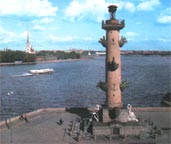 The city on the Neva riversides, which has celebrated its tercentenary in 2003, is one of the most attractive tourist centers not only in Russia, but also worldwide. Unique architectural ensembles, enchantment of numerous rivers and canals, attire of suburban palace-and-park ensembles-all this makes the image of St. Petersburg inimitable and enticing.
The city on the Neva riversides, which has celebrated its tercentenary in 2003, is one of the most attractive tourist centers not only in Russia, but also worldwide. Unique architectural ensembles, enchantment of numerous rivers and canals, attire of suburban palace-and-park ensembles-all this makes the image of St. Petersburg inimitable and enticing.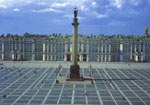 Address: Dvortsovaya emb., 34
Address: Dvortsovaya emb., 34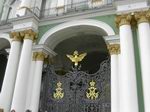 visitors. The tradition of collecting works of art became a part of the state policy. 19th century brought changes into the life of the royal residence. Interiors of the palace ensemble were changed according to the new tastes. Official and private life of the members of the royal family was connected with the walls of the palace, as well as the last page of the reign of the Romanovís dynasty.
visitors. The tradition of collecting works of art became a part of the state policy. 19th century brought changes into the life of the royal residence. Interiors of the palace ensemble were changed according to the new tastes. Official and private life of the members of the royal family was connected with the walls of the palace, as well as the last page of the reign of the Romanovís dynasty.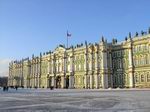 Put together throughout two centuries and a half, the Hermitage collections of works of art (over 3,000,000 items) present the development of the world culture and art from the Stone Age to the 20th century.
Put together throughout two centuries and a half, the Hermitage collections of works of art (over 3,000,000 items) present the development of the world culture and art from the Stone Age to the 20th century. 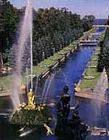 The world-famous palace, fountain and park ensemble of Peterhof is an outstanding landmark of Russian artistic culture of the 18-19th centuries. Founded in the very beginning of the eighteenth century by Emperor Peter the Great not far from his new northern capital St Petersburg , Peterhof was intended to become the most splendid official royal summer residence.
The world-famous palace, fountain and park ensemble of Peterhof is an outstanding landmark of Russian artistic culture of the 18-19th centuries. Founded in the very beginning of the eighteenth century by Emperor Peter the Great not far from his new northern capital St Petersburg , Peterhof was intended to become the most splendid official royal summer residence. 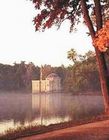
 Alexander Park
Alexander Park